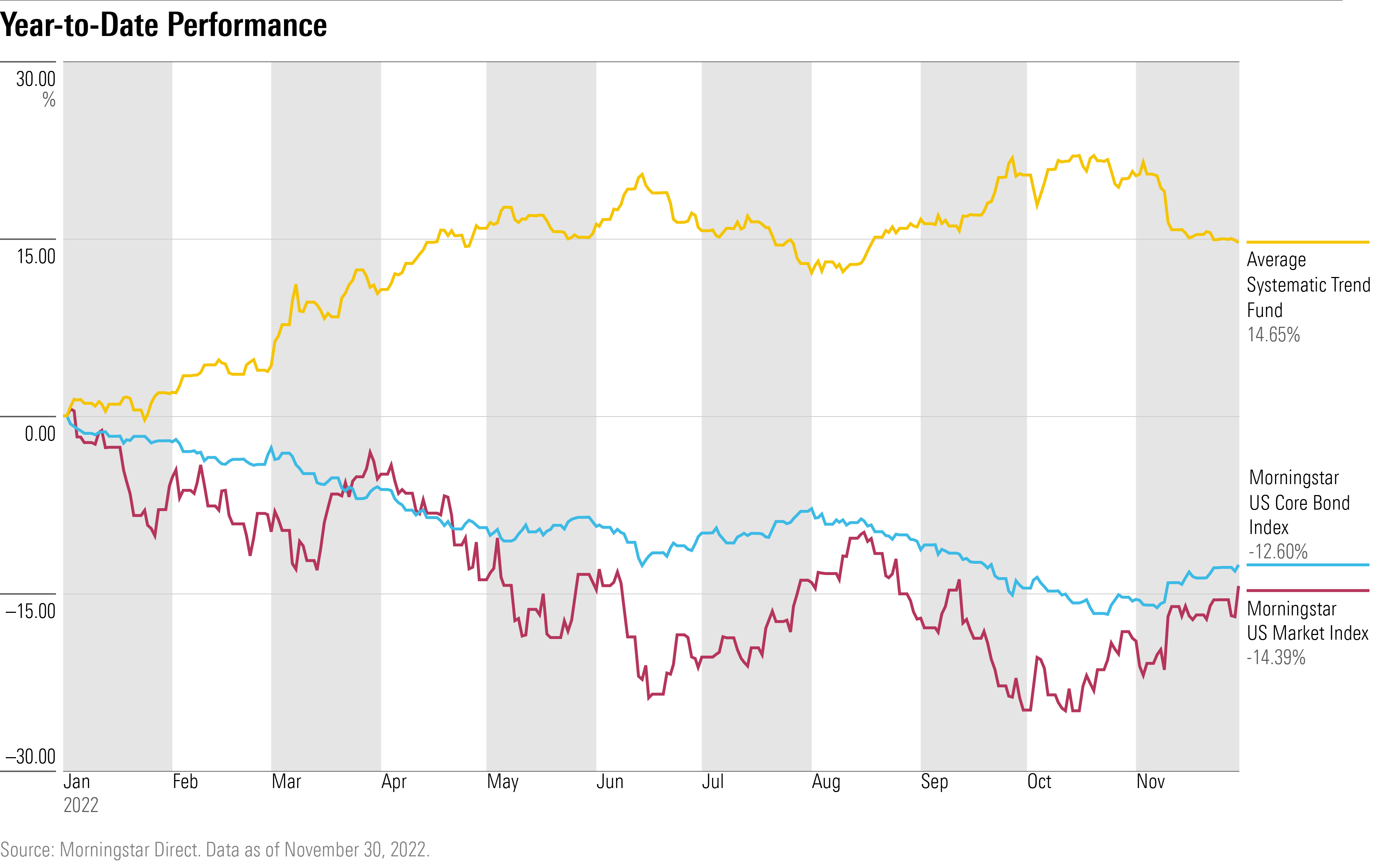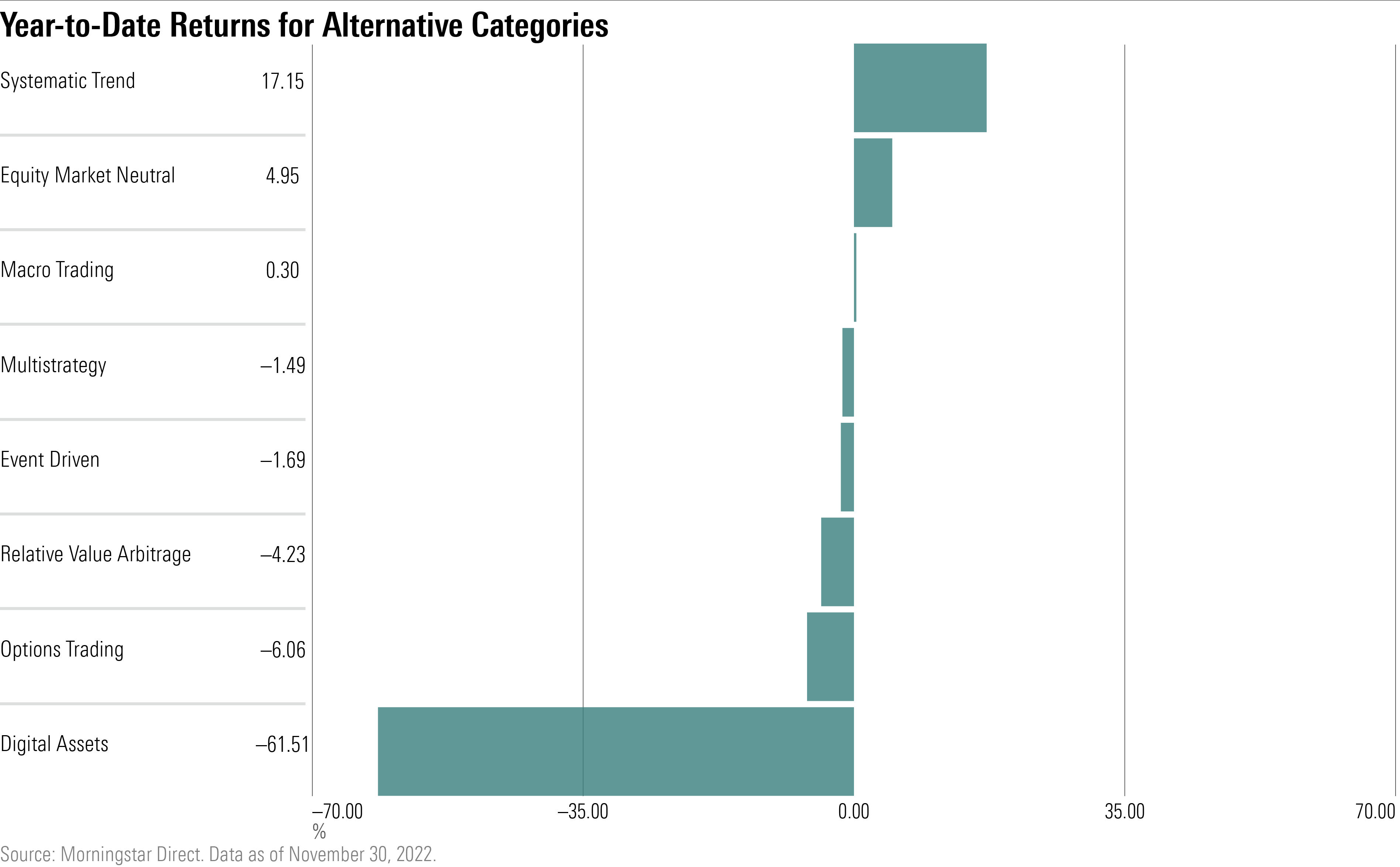Alternative Funds Are Winners in 2022
Many alternative strategy funds are successfully playing defense for investors in a brutal market.

For investors looking for shelter from the bear market in stocks, bond funds have not lived up to their expected role as a safe haven this year. But another group has: alternative funds.
Alternative funds are meant to provide diversification—mainly playing defense—in a portfolio by having returns that show little relationship to both stocks and bonds. To accomplish this, alternative funds use a wide variety of sometimes complex strategies.
Unfortunately, alternative funds sometimes have a reputation of overpromising and underdelivering. Fund investors, meanwhile, have a track record of moving money into alternative strategies after markets have already broken down, missing some of the benefits of diversification.
But for investors who held alternative funds in their portfolio coming into 2022, with the exception of strategies focused on cryptocurrencies, many have shown their merit this year.
The average alternatives fund is down 2.74%, while the Morningstar US Market Index is down 14.4% and the Morningstar US Core Bond Index is down 12.6%.
Among alternative categories, systemic trend funds are the best-performing group. The third-largest category of alternative strategies with $27 billion in assets, systemic trend funds are up an average of 17.15% so far this year. Event-driven funds, which hold $21 billion, are down 1.69% on average.
“It’s been a golden age for alternatives this year,” says Morningstar director of multi-asset ratings Jason Kephart. “They’ve done well because they have very little interest rate risk, a factor that has been painful for both stocks and bonds this year.”
What Are Alt Funds?
The alternative fund universe is broad and funds employ widely different approaches, leading to varied results in both the long and short term. (An overview of alternative strategies and how Morningstar categorizes alternative funds can be found here.)
“Alternatives are a very diverse space but they all aim to generate returns that are uncorrelated with stocks and bonds,” says Morningstar Investment Management senior investment analyst Michael Budzinski.
Some funds are opportunistic and try to outperform in every market environment, while others offer exposure to more specific events like mergers and acquisitions that carry more idiosyncratic risk. Some funds—known as market-neutral strategies—don’t shoot for big returns and instead aim for smaller, stable returns no matter the direction of markets.
While alternative strategies have fared well overall, the dispersion in strategies has been wide. Some opportunistic, trend-following strategies are up more than 30%, while the average digital assets fund, which provides exposure to cryptocurrencies, is down 60%.
Budzinski says investors need to have appropriate expectations for their alternative funds and understand the differences among strategies.
Other points for investors to consider: Alternative funds typically come with higher fees than other types of funds, and have been notoriously difficult for investors to time right, says Budzinski. For example, in 2021 the average alternative fund gained 0.65%, but the average investor lost 0.52% when they invested in an alternative fund. Rather than trying to time the market, and add alternative strategies when they think the market is going to be heading south, investors should stick with these funds for the long term and be willing to underperform in strong up markets, Budzinski says.
Which Alt Funds Have Outperformed?
Systematic, or trend-following funds, are top performers among the alternatives group in 2022 with the average fund in the category up 17.2% this year. Systematic trend funds mainly implement strategies designed to identify and profit from short-term trends across a variety of markets, including stocks, bonds, currencies, and commodities. These funds do especially well when there are clear, strong moves in the markets either up or down.
“As many of the slow-moving trends from 2021 picked up steam in 2022, these strategies have taken off,” says Kephart. Among the clear trends that many funds were able to profit from in 2022, the U.S. dollar posted a strong rise, and energy and commodity prices skyrocketed. In addition, as interest rates rose, investing on the expectation that bonds would fall in price produced strong returns, he says. For example, the Morningstar US Core Bond Index declined 12.60% this year, and 1.61% in 2021.

The $3.2 billion AlphaSimplex Managed Futures (AMFNX) has been one of the best-performing alternative funds this year, gaining 36.83%. “During 2021 and 2022, trend followers have excelled and AlphaSimplex has capitalized,” writes Morningstar director of alternative ratings Simon Scott.

A number of equity market-neutral funds have also outperformed.
Under the hood of those strategies, equity market-neutral funds try to exploit different factors. This year, strategies that emphasized the outperformance of stocks with value characteristics have done particularly well, as the decadeslong trend of technology companies leading the market has come to an end, Kephart says.
The $184.3 billion AQR Equity Market Neutral (QMNIX) is one example. The fund uses value, momentum, and quality indicators to find stocks to own which will perform relatively well, while betting that stocks with weak indicators will perform relatively poorly, and then profiting from the spread between those positions.
The AQR Equity Market Neutral fund has for several years had a bias toward owning stocks with heavy value characteristics. “A reversal of the negative trends for value signals has recharged AQR’s global stock-selection model since late 2020,” writes Scott. The fund is up 23.33% so far in 2022, which follows a 17.62% rise in 2021. However, this follows three years of underperformance for the fund.

Funds that base strategies on macroeconomic trends have had less success this year, with the average fund in the category gaining 0.30%. These funds generally invest globally in a range of assets including currencies and commodities, as well as stocks and bonds. Two outperformers in the group this year are the $758.1 billion Campbell Systematic Macro I (EBSIX), up 33.61% so far in 2022, and the $158.3 million AQR Macro Opportunities (QGMRX), which is up 26.58%.
Outside of more opportunistic strategies, event-driven funds are down 1.69% on average and relative value arbitrage funds are off 4.23% on average. Both categories of funds provide exposure to a variety of idiosyncratic risks—stock price changes owing to security-specific factors rather than the wider market, write the authors of Morningstar’s 2021 Global Liquid Alternatives Landscape.
The largest and one of the oldest alternative funds, the $15.9 billion Calamos Market Neutral Income (CVSOX), is down 4% this year. This fund has a somewhat different focus than many market-neutral funds, looking to profit from convertible securities arbitrage.

Combining strategies has produced muted returns, but is still better than those of the broad stock and bond markets. The average multi-strategy fund is down 1.49% while one of the largest, the $9.8 billion BlackRock Systematic Multi-Strategy (BKMBX), is down 4%.
Digital Asset Funds Implode
A significant exception to the solid performance of alternative funds in 2022 has been digital asset funds, which mostly buy and hold cryptocurrencies.
The largest digital asset fund, the $10.8 billion Grayscale Bitcoin Trust (GBTC), is down 64.42% through Nov. 30 following the collapse of the cryptocurrency market.
Even with the terrible year, Grayscale Bitcoin Trust and Pimco Trends Managed Futures Strategy (PQTIX) returned the most over the past five years among the largest alternative funds. The $5.0 billion Pimco Trends Managed Futures Strategy is up 8.22% over the past five years.
The author or authors do not own shares in any securities mentioned in this article. Find out about Morningstar’s editorial policies.

/s3.amazonaws.com/arc-authors/morningstar/8b2e267c-9b75-4539-a610-dd2b6ed6064a.jpg)
/cloudfront-us-east-1.images.arcpublishing.com/morningstar/T5MECJUE65CADONYJ7GARN2A3E.jpeg)
/cloudfront-us-east-1.images.arcpublishing.com/morningstar/VUWQI723Q5E43P5QRTRHGLJ7TI.png)
/d10o6nnig0wrdw.cloudfront.net/04-22-2024/t_ffc6e675543a4913a5312be02f5c571a_name_file_960x540_1600_v4_.jpg)
:quality(80)/s3.amazonaws.com/arc-authors/morningstar/8b2e267c-9b75-4539-a610-dd2b6ed6064a.jpg)